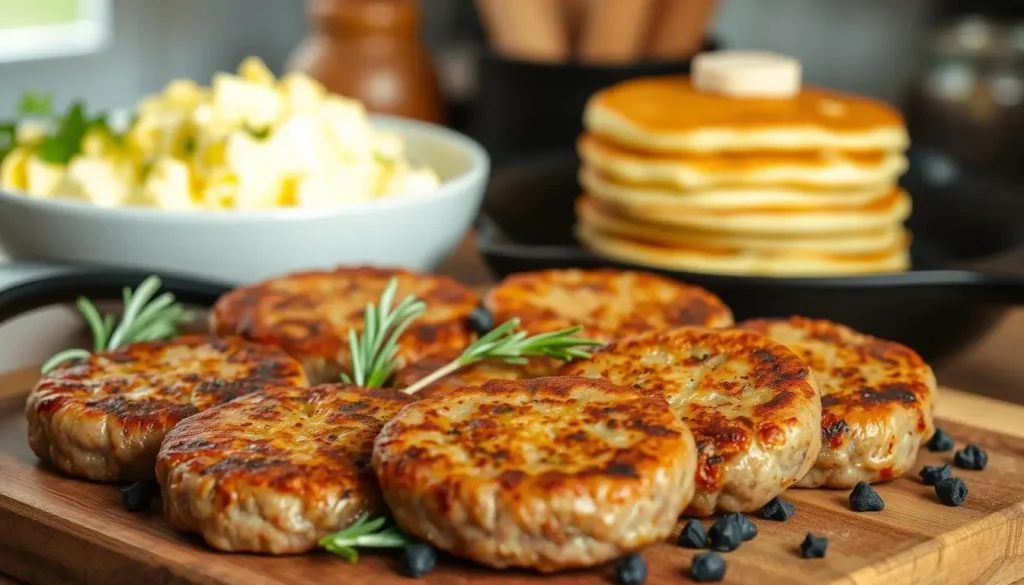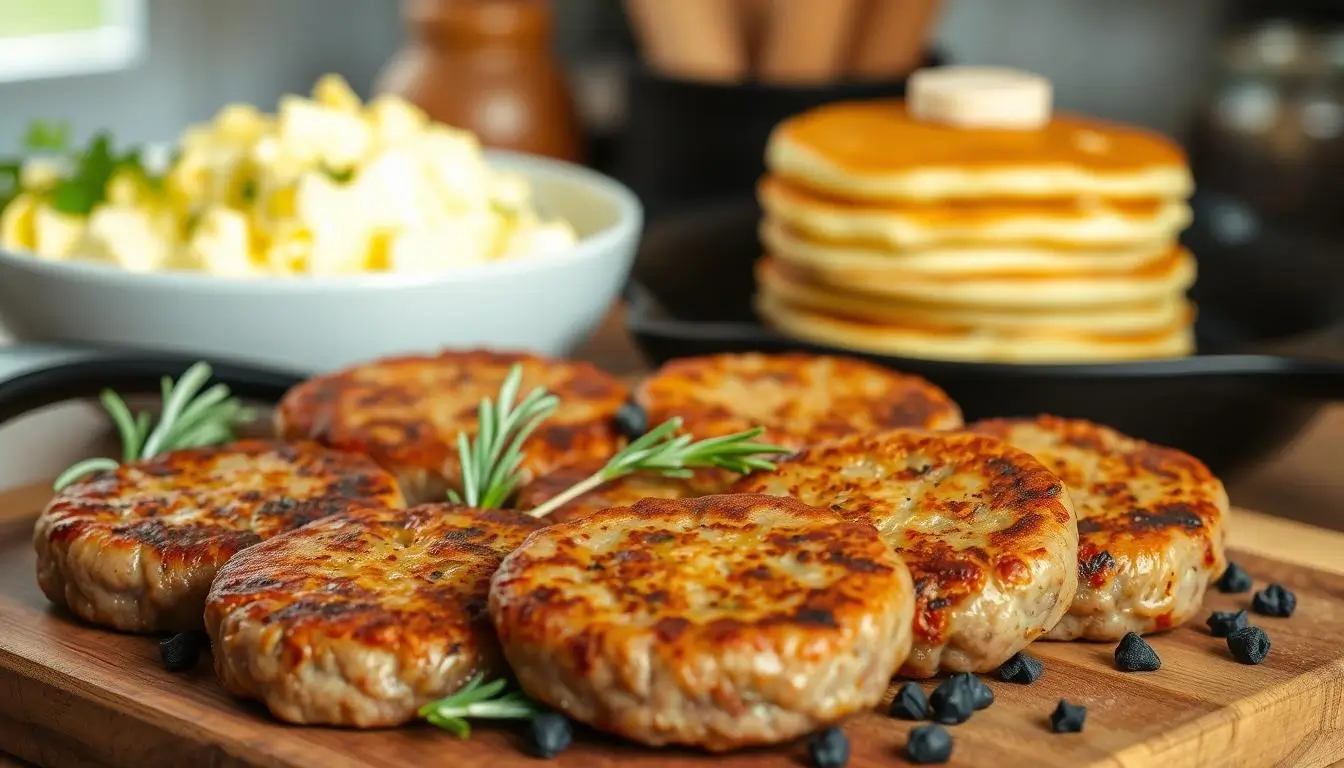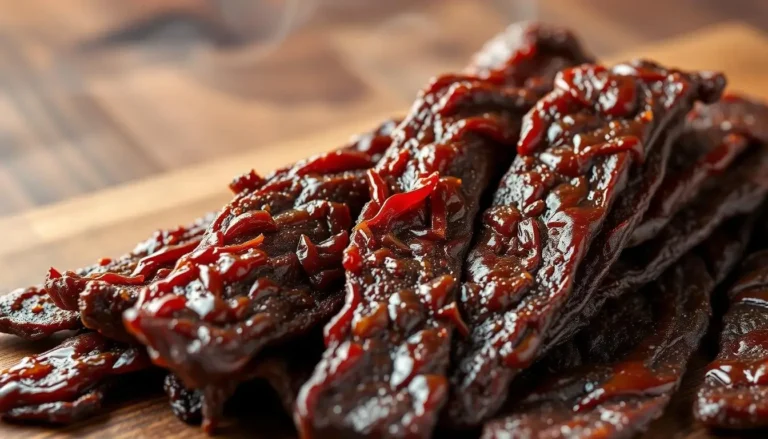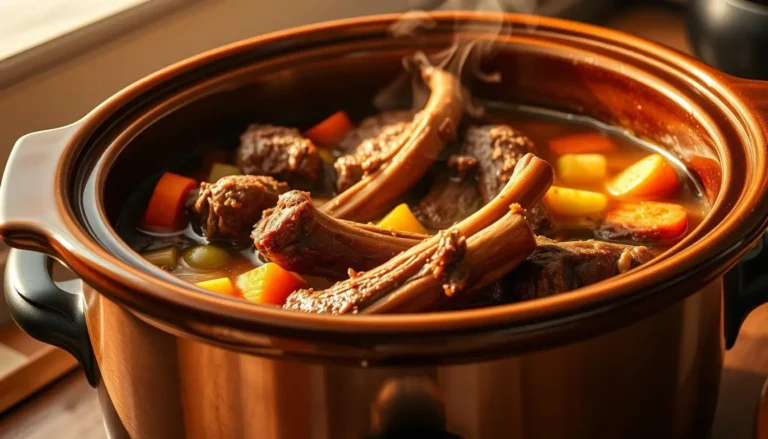How to Make Beef Breakfast Sausage at Home: A Simple Guide
Table of Contents
How to Make Beef Breakfast Sausage at Home
Picture this: It’s a lazy Sunday morning, and you’re craving something hearty. Store-bought options feel bland, but you’re not sure where to start. That’s when homemade patties come to the rescue. With a few spices and ground beef, you can craft a meal that’s both flavorful and satisfying.

This guide walks you through every step. You’ll learn how to mix seasonings like brown sugar and sage into 2 pounds of 80/20 ground beef. Shape the blend into eight even portions, then chill them overnight. This 24-hour rest lets flavors meld beautifully.
Cooking is straightforward. Use a large nonstick skillet on medium heat for even browning. Aim for an internal temperature of 160°F—this ensures safety without drying out the meat. Prefer extra spice? Toss in red pepper flakes or adjust herbs to your taste.
Whether you’re meal-prepping or hosting brunch, this recipe adapts effortlessly. Below, we’ll dive into ingredient ratios, shaping tricks, and pro tips from trusted culinary sources. Let’s get started!
Key Takeaways
- Create 8 flavorful patties using 2 pounds of 80/20 ground beef and customizable spices.
- Refrigerate the mixture for 24 hours to enhance taste and texture.
- Cook evenly in a large nonstick skillet over medium heat for optimal results.
- Achieve safety by ensuring the internal temperature reaches 160°F.
- Adjust seasonings like sage or red pepper flakes to suit personal preferences.
Gather Your Ingredients and Equipment
Starting with the right components sets the stage for success. Using high-quality ingredients—fresh spices and dependable tools is crucial for achieving the best results. Let’s break down what you’ll need to build bold flavors and achieve even cooking.

Essential Ingredients and Seasonings
For eight patties, grab 2 pounds of 80/20 ground meat. This fat ratio keeps them juicy. Combine it with 1½ teaspoons each of brown sugar, dried sage, and basil. Incorporate 1 teaspoon of onion powder and marjoram, along with ½ teaspoon of crushed red pepper. The sugar balances heat, while herbs create earthy depth.
Use a large bowl to mix everything evenly. Measuring spoons ensure accuracy—no guessing. Let the mixture rest overnight. This 24-hour chill lets flavors fuse, transforming simple spices into a cohesive profile.
Choosing the Right Cookware: Nonstick Skillet and Alternatives
A large nonstick skillet is ideal for cooking. Its surface prevents sticking and promotes golden browning. Heat it on medium heat to avoid burning. No nonstick pan? A well-seasoned cast-iron skillet works too—just add a teaspoon of oil.
Prefer a griddle? It’s great for batch cooking. Either way, keep the temperature steady. Uneven heat leads to undercooked centers or charred edges. Pair your cookware with a meat thermometer for safety checks.
Now that your tools are ready, the next step focuses on shaping and seasoning adjustments. Master those, and every bite will deliver restaurant-quality taste.
Perfecting Your Beef Breakfast Sausage
Mastering the art of flavorful, tender patties requires precision and creativity. Let’s delve into the art of balancing spices, ensuring even portion sizes, and customizing the dish to suit your tastes.
Mixing Spices for Outstanding Flavor
In a small bowl, mix together 1½ teaspoons of brown sugar along with dried sage and basil. Add onion powder, marjoram, and crushed red pepper. Sprinkle this blend over 2 pounds of ground meat, then use your hands to distribute it evenly. Gentle mixing prevents toughness—think folding, not kneading.
Brown sugar adds subtle sweetness, while sage delivers earthy warmth. Red pepper flakes introduce heat. For accuracy, measure spices with leveled teaspoons. Overpowering flavors? Reduce pepper or skip marjoram.
Forming Consistent Patties
Divide the mixture into eight portions using a kitchen scale or ice cream scoop. Shape each portion into a round that is ½ inch thick, ensuring the edges are smooth with your hands. Uniform size ensures even cooking—no raw centers or burnt spots.
Chill shaped patties for 10 minutes before cooking. This firms them up, reducing breakage in the skillet. Want crisp exteriors? Avoid overcrowding the pan during cooking.
Adapting the Recipe to Your Taste
Customize spice levels by doubling red pepper or using smoked paprika. Add 1-2 tablespoons of water if the mixture feels dry. Nutrition-wise, each serving packs 220 calories and 18g protein—ideal for protein-focused diets.
Stick to the core recipe for classic flavors, but don’t shy from experiments. Swap basil for thyme or add garlic powder. Your kitchen, your rules!
Cooking Tips for Delicious Sausage Patties
The sizzle of perfectly cooked patties starts with smart techniques. Your choice of equipment and temperature control can elevate golden-brown results or leave you with uneven textures. Let’s explore how to maximize flavor while keeping every bite juicy.
Skillet Versus Griddle: Which to Choose?
A large nonstick skillet excels at even heat distribution. Preheat it over medium heat for 2 minutes before adding patties. Cook 3-4 minutes per side—this creates a crisp crust without sticking. Need to feed a crowd? A Blackstone griddle lets you cook eight patties at once. Just add ½ teaspoon of oil to prevent drying.
Griddles require slightly lower heat to avoid scorching. Add a dash of red pepper flakes while cooking to give it an extra kick. Both tools work, but skillets offer better control for home cooks.
Achieving the Ideal Internal Temperature
Place an instant-read thermometer into the thickest section of a patty. Target a temperature of 160°F—this guarantees safety and helps retain moisture. When using an air fryer, cut down the cooking duration by 2 minutes on each side. Watch for steam: If your skillet smokes, lower the heat immediately.
Enhance flavors by dusting cooked patties with a dash of pepper powder or dried sage. Let them rest 1 minute before serving. Overcooking dries them out, so set timers and trust the thermometer.
Remember: Consistent heat and patience yield tender results. Adjust spices as needed, but stick to core ingredients for balanced taste. Now, fire up that skillet and savor the sizzle!
Conclusion
Crafting flavorful patties at home is simpler than you think. Start by combining spices like salt, garlic, and onion powder with your meat mixture in a large bowl. Shape into eight portions, then cook until the center reaches 160°F for juicy, safe results every time.
This recipe delivers 18g of protein per serving while keeping fat content minimal. The balanced mixture of herbs mimics the rich depth of a slow roast—no fancy equipment needed. Adjust spice levels or swap seasonings, but keep the base ratios intact for consistency.
Keep any remaining portions in the refrigerator for 3-4 days or opt to freeze them for a duration of up to 3 months. With this information, you’re equipped to create meals that satisfy both taste buds and nutritional goals. Why settle for bland options when your skillet can deliver golden perfection?
Grab your bowl, tweak that salt level, and make mornings memorable. Your kitchen adventures just got a protein-packed upgrade!
FAQ
Can I use a regular skillet instead of nonstick cookware?
Yes, but lightly oil the surface to prevent sticking. Cast iron or stainless steel skillets work well, though they may require adjusting heat levels for even cooking.
What spices pair well with this recipe?
Sage, smoked paprika, and garlic powder are classic choices. For heat, add crushed red pepper. Experiment with thyme or fennel seeds for unique flavor profiles.
How do I ensure patties hold their shape while cooking?
Chill the mixture for 15–20 minutes before forming patties. Press them firmly but avoid overhandling, as this can make the texture dense.
Is it necessary to use a meat thermometer?
For safety, check that the internal temperature reaches 160°F (71°C). A thermometer ensures juicy results without overcooking.
Can I freeze uncooked patties for later use?
Absolutely. Layer parchment paper between patties in an airtight container. Freeze for up to 3 months and cook straight from frozen.
What’s the best way to adjust seasoning if I prefer less salt?
Reduce sodium by using low-sodium spices or herbs like rosemary. Taste-test a small cooked portion before shaping all patties.



